Communication in mediation
25 Basics of mediation (20)
The following’s the issue:
- Basic ideas about communication (Can we even understand each other?)
- How can we model communication?
(You will not find anything on non-violent communication at this time. )
I. The mediator promotes communication between the parties in mediation
This is finally the 20th part of the series „25 Basics of Mediation“. The focus will be on ideas and concepts that make things understandable, what communication is and how mediators model communication. It is not so much about the technical interventions, but rather about the diversity of ideas that these interventions generate.
The key question par excellence, when it comes to the conception of the communication process:
Is it even possible to understand each other?
But first things first. Mediators have to fulfil their task of § Section 2 (3) of the Mediation Act as follows.
„The mediator… promotes communication between the parties…“
Mediation has always had a complex relationship with communication. It is ambivalent anyway.
Mediators always run the risk of being seen as the „better communicators“ because they offer counselling services that are typically provided for a communication system that is in an escalated conflict. And even if mediation often emphasises that it is process consulting, i.e. that it attempts to bring about a more successful resolution of the previously unsuccessful conflict resolution process, mediators are still acting as consultants when they suggest mediation as the method of choice to the conflict parties!
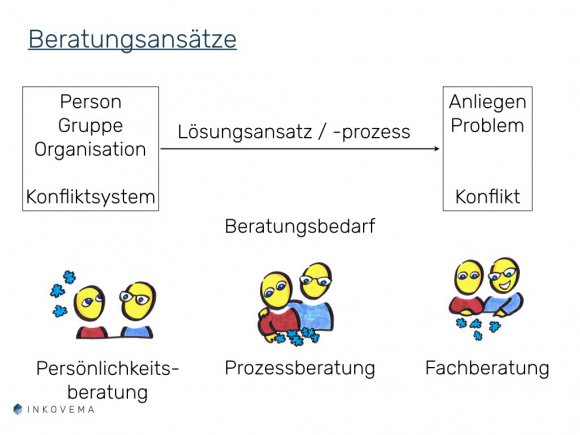
II The understanding of communication in mediation
1 What does the term communication mean?
The original word stem munus means Task, function, service, duty or fulfilment. The Old Latin prefix con- or com- means with, together or jointly. The Jointly performed friendly or hostile.
Since then, however, the concept of communication is no longer only used in the sense that something done and accomplished together but often means that there is simply contact. On the one hand, this has to do with the technical possibilities of communication (telegraphing, telephoning, faxing), which depended on establishing contact in order to exchange messages. On the other hand, it probably has to do with the development of American English in the vastness of North America since the 18th century: In Communication with… or have established a connection… covers above all a functional content, the compound produced, no longer doing things together.
2 Modern communication theories reflect these meanings
A more humanistically charged understanding usually refers to the meaning „do something together“, "do more together, communicate". This is about the endeavour to reach an understanding, guided by reason and rationalised. These ideas have found expression in a rationally orientated or understanding-orientated communicative action as is the case with Habermas is expressed.
It is above all the system-theoretical-functional approaches, which refer to the functioning contact between the "somehow networked and connected" and to conceptualise and model communication according to this functionality. If we follow this idea, communication can be conceptualised in a completely different way „ and incorporated into a theoretical framework, such as the one developed by Niklas Luhmann has succeeded. Of course, its concept of communication is not explicitly applicable in mediation, but it is invaluable for mediation (especially in the context of organisations). It is still used far too little.
If you have any other tips, experiences or confirmations in this regard, please use the comment function at the end of the post!
For example, the diversity of such approaches is already evident in the question posed at the beginning of this article. fundamental question: Is communication even possible? Can two people even be sure that they have understood each other?
3. we can already understand each other
One starting point could be the idea that we humans can understand each other. We can imagine communication as if a message is packaged, sent out and the communication partner has to unpack this message and can then understand it. This idea models communication with the help of a sender-receiver model and assumes that a message or information is transmitted from a sender to a receiver.
Difficulties, communication problems and conflicts then appear to be the result of transmission or translation problems. In these cases, the transport process or the encoding or decoding has failed. In principle, however, this is a problem that can be solved, not purely technically, but in a very similar way.
4. we can't understand each other at all
The constructivist epistemologists to the matter. They ask how we perceive the world (and therefore also our communication partners) in the first place. After all, the world does not penetrate us and we are helplessly at its mercy, but rather we perceive the world mediated by our sensory organs: the world stimulates these sensory organs so that their structures change, which is then registered by our brain. We make sense of this. What applies to the world in general also helps us to understand communication with another person. Their messages and information are not carried into us. Rather, they gain meaning through our own structural changes. Meaning cannot be made to us – and someone else's talk alone does not make sense either. But it's not pointless either. That is just a convention of nonsense.
Accordingly Agreement, consensus and mutual understanding are a communicative construct, that stabilises the mutual certainty of expectations (Luhmann) and enables hope and the illusion that nothing bad is to be expected – and that further communication can follow.
However, we cannot test the content of our agreement definitively because we do not have access to the other person's mind. We cannot see the world completely through the eyes of the other person, but we can make a credible attempt for the other person, communicate what we see with our own eyes and hope that the other person understands it the way they understand themselves, do you understand? All examination is also communication.
But enough of the general preamble.
III Basic models of social communication
In mediation, there are various communication models from which interventions are derived or which are used to diagnose conflict communication. I will only be able to present them briefly below.
However, if you would like to read more about a concept, please write to me in the comments and I will endeavour to comply with your requests.
1. model of pragmatic communication
The model of pragmatic communication originates from early systems theory – i.e. before N. Luhmann's systemic turn in the mid-1980s. It is largely based on P. Watzlawick who has applied the authoritative findings of systems biologists to Maturana and Varela processed in it.
As a social psychologist, Paul Watzlawick was interested in the Conflict potentials of the social relationship, that arise through communication. This is why misunderstandings, ambiguities, paradoxes and disruptions in communication play such an important role in his work. He is considered a master in analysing and uncovering home-made problems and self-inflicted conflicts, which can be laughed about afterwards.
Based on the theoretical models for the technical transmission of radio waves, including their decoding by transmitters and receivers (development of the radio), Watzlawick uses the Transport model by Shannon & Weaver (1949) as a starting point.
He enriches this model significantly in order to emphasise the misunderstandings and paradoxes. The theoretical foundations are derived from the cybernetic circles around Heinz von Foerster and the early systems theory (Norbert Wiener)that is, before Luhmann's sociological systems theory.
Cybernetics was concerned with questions relating to the control of systems (of all kinds). Drawing on this knowledge, Watzlawick understood the communicative process of the participants as the events of a (single) system, whose elements influence each other and interact. However, this influence is not linear and monocausal, but rather mutually feeding back. The system is constantly Feedback processes that contribute to the stabilisation or destruction of the system.
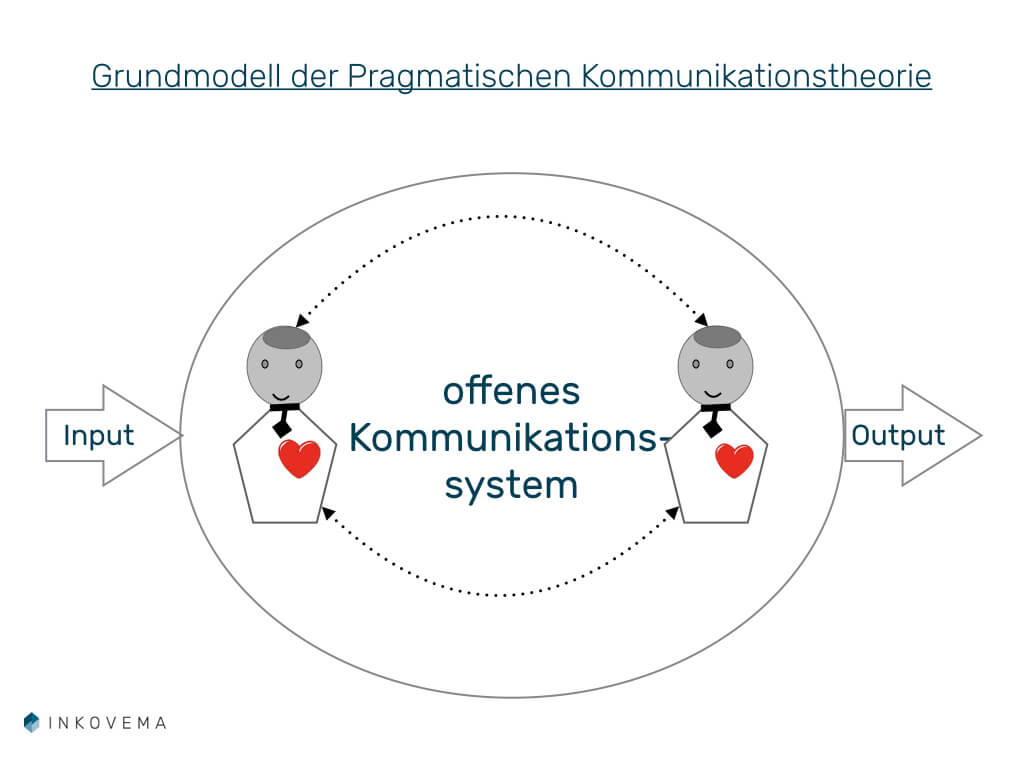
Based on the feedback loops and the resulting recognisable inputs and outputs of the system, the Circularity of the communication processes without having to or being able to gain a direct insight into the "inside". There is therefore no beginning or end to the communication system. The communication system is a black box.
Nevertheless, Watzlawick Five axioms of communication derived – some of which have already become household words.
- Axiom No. 1: It is impossible not to communicate in the presence of others.
- Axiom no. 2: All communication has a content aspect and a relationship aspect.
- Axiom No. 3: The subjective punctuation of the sequence of events defines the relationship.
- Axiom no. 4: Communication can be digital or analogue.
- Axiom no. 5: Communication is either symmetrical or complementary.
Equally important is the differentiation between the content level and the relationship level, which almost all subsequent communication models have adopted and deepened.
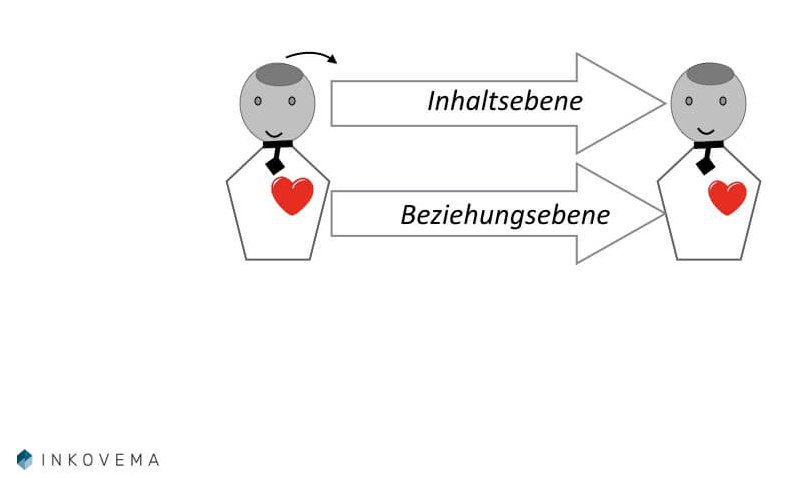
2. the four dimensions of communication.
Friedemann Schulz von Thun presented the practice-orientated and therefore excellently suited for explicit work. Model of the four ears or four mouths on. I prefer the term four dimensions. The model captures communication using the sender-receiver model and presents conflicts or problems of understanding in a rather technical way. In fact, the model offers a lot of possibilities to intervene in the case of conflicts and to stimulate necessary changes of perspective. It models four different areas and functions that communication - understood here as communication in the form of an action - fulfils.
These four dimensions are the
- Factual dimension,
- the self-disclosure dimension,
- the relationship dimension and
- the appeal dimension.
The following tables show what this involves in concrete terms and an example.
| COMMUNICATION:
What is communicated? |
UNDERSTANDING:
What do I understand/construct as a result of this message? |
| FACTUAL DIMENSION:
What do I want to inform about? |
FACTUAL DIMENSION:
How is the factual content to be understood? |
| SELF-DISCLOSURE DIMENSION:
What do I reveal and say about myself? |
SELF-DISCLOSURE DIMENSION:
What kind of man is he? What about him? |
| RELATIONSHIP DIMENSION:
What do I think of you and how do I feel about you? |
RELATIONSHIP DIMENSION:
How does he talk to me? What does he believe connects us? |
| APPEAL DIMENSION:
What do I want to achieve with you and what should you do? |
APPELDIMENSION:
What should I do, think and feel now? |
You will find some examples of messages in the following table:
| Message | Communication | Understanding |
| FACTUAL DIMENSION | Where did you put the file, Mrs Meier! | Where did he put the file? |
| SELF-DISCLOSURE DIMENSION | I don't know where you've put the file. I can't find it. | He doesn't feel like looking! He's angry with me // He wants contact with me, wants to talk. |
| RELATIONSHIP DIMENSION | You'll know from both of us where the file is.//
Compared to you, I am a zero. |
I have to do every little thing for him.
If he didn't have me. |
| APPEAL DIMENSION | Please tell me where you have put the file.
Do something faster! |
He wants me to bring him the file!
I should feel bad because I've made a mistake / I should mother him because he's so helpless |
3. model communication according to transactional analysis
The communication model of transactional analysis was largely developed by Eric Berne and is based on his personality model, the structural and functional analysis of ego states and behavioural modes. The details are highly contradictory, controversial and stand on shaky ground. Nevertheless, it is ideally suited for explicit work in mediation. It is catchy and can lead intuitively out of distressing situations.
Transactional analysis also uses the sender-receiver model for modelling and subdivides the possible behavioural modes of people into different patterns of behaviour: Parental, childlike and adult behaviour patterns serve as a basic template for categorisation.
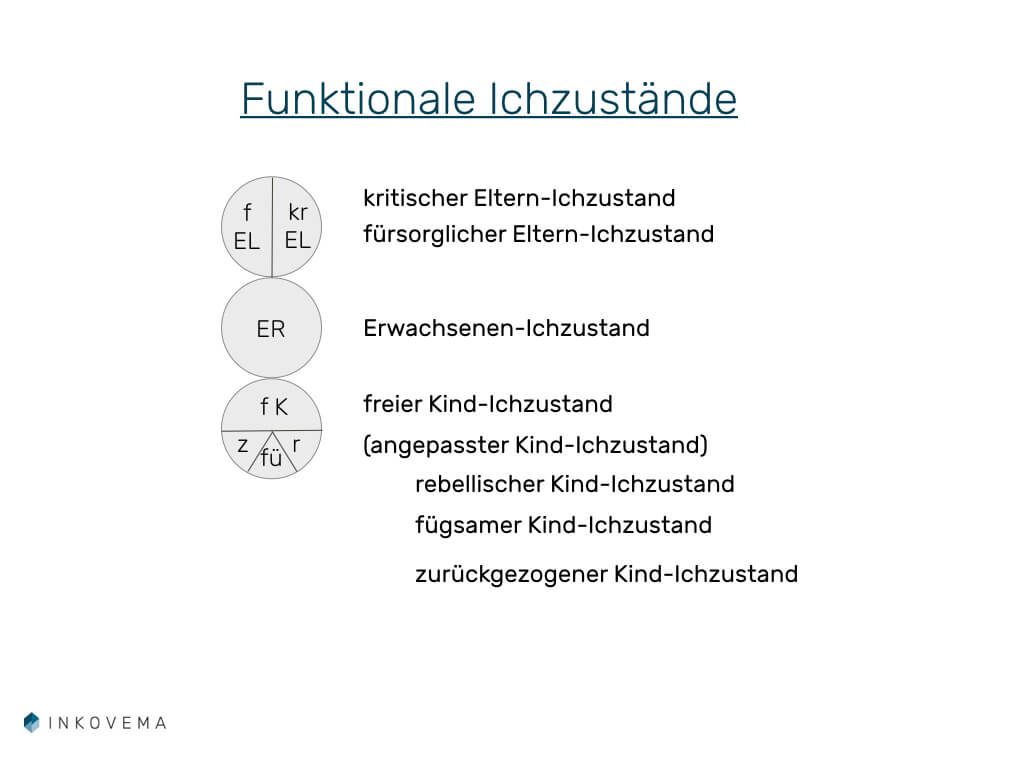
With the help of this model, communication can be visualised as follows.
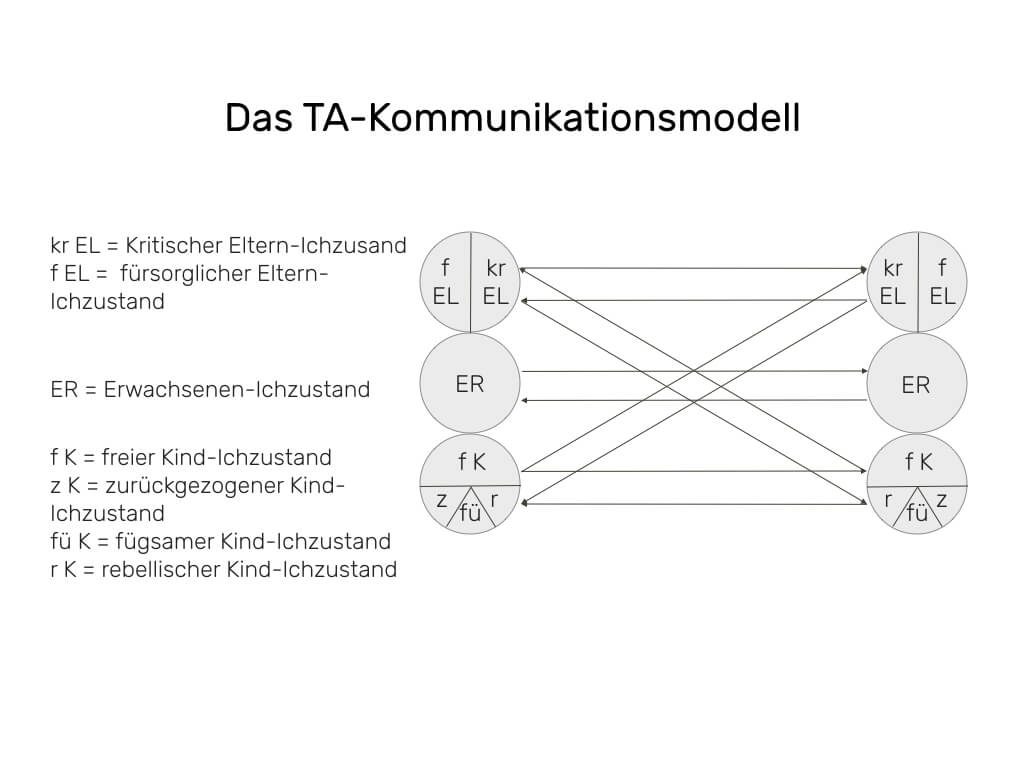
The sketch shows all variants of Communication types on.
The following are a few examples to illustrate the idea of transactional analysis.
- Complementary transaction (parallel transaction)
- Irritating transaction (crossover transaction)
- Concealed transaction (ambiguous transaction)
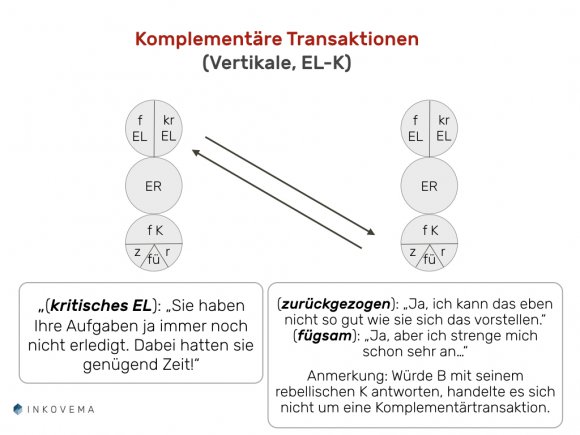
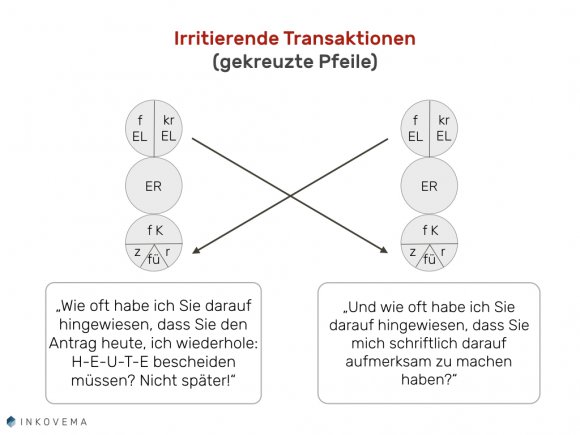
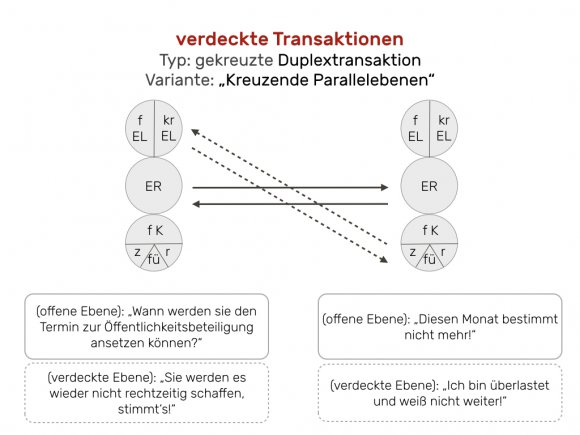
4. systems theory model according to Luhmann
Completely out of the ordinary is the system-theoretical model of communication according to N. Luhmann, the findings of the Systems biologists Maturana and Varela to social systems. This significantly initiated the so-called systemic turn, according to which the concept of autopoiesis (= the process of self-creation and self-preservation of a system) found its way into sociology.
After that, systems theory was no longer what it was before. And yet today everything is called „systemic“ that believes it can think two elements together.
However, I would like to briefly outline here how differently systems theory has modelled communication since then. It is unfamiliar and the consequences are hard to assess when first „thinking in this theoretical framework“. It mixes everything up. So here are just a few highlights of the communication concept and an overview.
- People cannot communicate, nor can brains or consciousnesses, but only communications can communicate.
- Communication consists of information, communication and understanding. This is the 3-in-1 package. One Information is different to the message, because it could be completely different. The Communication is different to understanding, because it could be omitted or done in a different way. And that Understanding is different to information and communication, because it could turn out differently. Understanding completes the threefold selective unit and generates communication.
- Humans, biological systems and psychological systems (consciousness) are necessary conditions for communication to be possible, but they are not part of the communication system, they are part of the system's environment. They are the condition of possibility, but not the system itself.
In sketch form, it looks something like this:
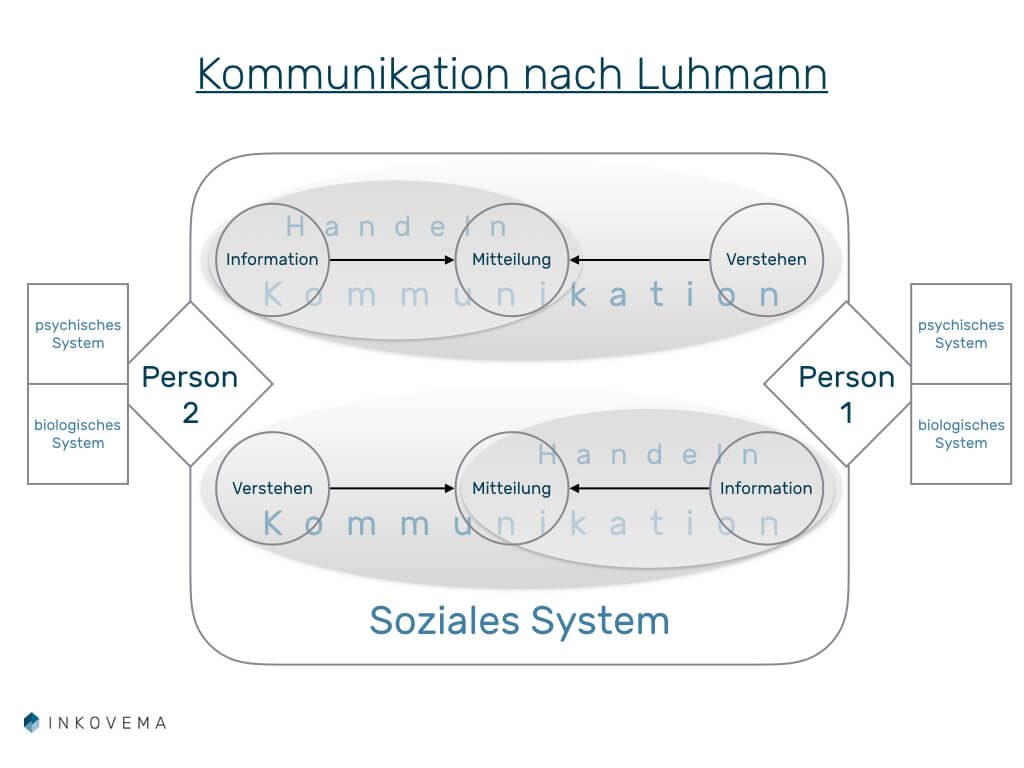
- Luhmann thus follows not an action-theoretical approach, but a consistent system-theoretical approach. An action that is attributed to a person and evaluated as part of communication is the invention of communication (camouflage).
- In any case, the whole transport metaphor of a sender-receiver model seems questionable, i.e. that information would be thought of as objects that have to be packaged, transported, unpacked, where information is given and received. For constructivists and sociological systems theorists, the whole thing sounds too much like post, telegraph and radio technology. For them, it has little to do with interpersonal communication.
- important Findings from it:
- Understanding is impossible for the mental systems as a result of communication. Mental systems cannot communicate, communication cannot think.
- That is why it is not easy to talk about understanding, not understanding and misunderstandings. But that doesn't go without saying either.
- Reflection is exhausting. It is not possible to improve communication by metacommunicating at will. At some point, the limit of usefulness is reached and the environment is overburdened: The mental systems can no longer provide sufficient attention for further communication. They feel the need for something new, their load limit seems to be reached. Or to put it more simply, it cannot be followed up more and more precisely!
- And in relation to the discussion on values: Those who argue on the basis of value use a value bonus, not only claiming the value of the value, but holding it hostageThe other person must speak up if they disagree and run the risk of being rejected as a result. Under the protection of the beauty and goodness of values, arguments are made and the complexity of the contradiction is left to the other person. The other person then bears the burden of argumentation.
With regard to sociological systems theory, it can be said that it can hardly play out its benefits in classical mediations, but this is immediately apparent. changes in the context of organisations. Systems theory considerations are necessary and helpful in order to take adequate account of the complexity of conflicts there. Even if access to this way of thinking is not easy, its benefits are always rewarding enough.

Thank you for this nice summary of the most important communication models. I think it shows very impressively how complex communication is and gives an idea of the challenges we mediators face in this area.
The file is a very good example. The functional ego states and the TA communication model are exciting.
Thank you very much, Gudrun, I fully agree with you and this is what makes mediation so valuable for the conflicting parties, who generally strive for an under-complex solution to their conflict - and thus fuel it.
Dear Kerstin, we will certainly deal specifically with the TA communication model in the basic training. Promise ?
Hello Sascha,
I'm convinced of that! I'm excited and looking forward to it!